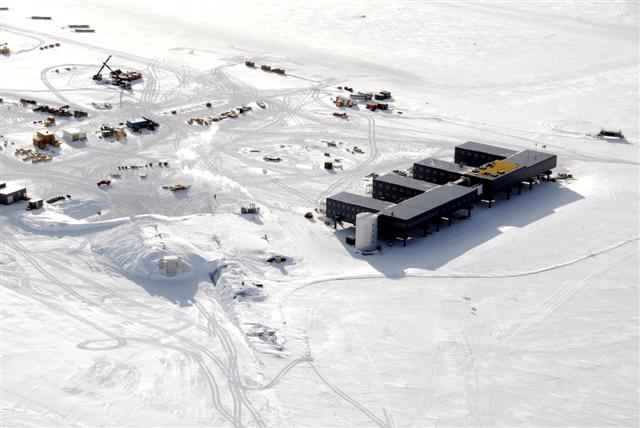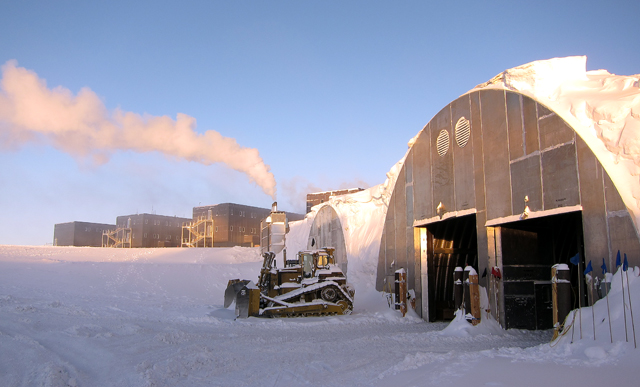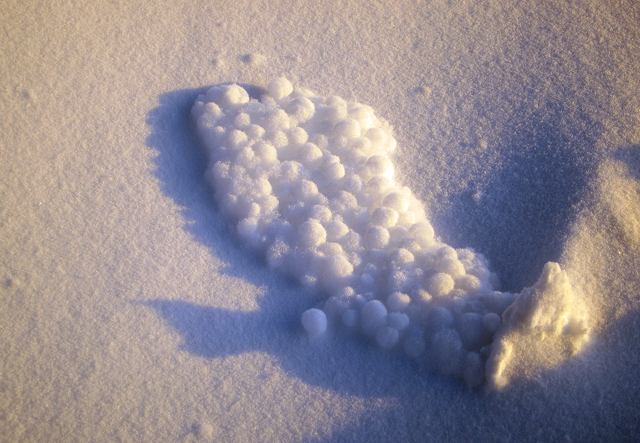Page 2/2 - Posted April 9, 2010
An unimaginable discoveryBy the time I made it to the end of my line this particular morning, the sun was sharply bright and orange, glowing brightly, flickering in and out of the power plant exhaust. I was also starting to feel the cold on the minute bits of skin on my cheekbones exposed to the cold, the wind deftly seeking access through my face gear. My fingers were a bit chilled but nothing beyond the norm in which I function quite easily. I headed down the two-step slope at the end of the A Pod wing on the station, past the power plant and down into the valley that contains the logistics arch (LO) and the vehicle maintenance facility (VMF). A normal day. It wasn’t until I was climbing back out of the VMF, just leaving the doorway behind me, that my heart fluttered for the first time. At my feet were balls of white things rolling around and gathering in little fuzzy piles in every depression in the snow. My initial thought was, “Oh no, not more cotton balls!” I’d spent my fair share of time last winter sorting fresh white cotton balls from white snow. I’d actually spent several days doing it. I knelt in the tracks left by the loader and peered closely at these balls. I picked them up in my mittens. I crushed them like air. Not cotton. Soap bubbles? Was there a bubble bath on station no one told me about? Nope. I was dumbfounded. Had one of the pieces of heavy equipment been spewing some soapy stuff behind it? I continued on my way up the VMF slope and noticed more and more of these collections of tiny balls of frozen airy bubbles. By the time I reached the top of the slope, I was back inside the glow of the sun shining long and low across the snow ahead of me. And what I saw amazed me: Rolling, dashing balls of light snow, chased and hurried across the uneven snowscape by the light wind at my back. The way these bubbles traveled was like nothing so much as when the bubbles from a soapy car wash escape in the summer wind and roll off with that slightly rubbery flexibility and lightweight escape. But this was at minus 78F at the South Pole. As far as I could tell, I’d stumbled into a desert world populated by miniature crystal tumbleweeds. Every tiny, dancing ball of breathy ice caused me to almost stumble in my tracks. Was I the only one seeing this? What was this? Where was it coming from? Did we humans cause this? My mind raced but also it sat still and stunned in my head as I stood watching this phenomenon in utter mind-boggled gratitude. Every tiny drift and old footprint in the snow had gathered a wee collection of these balls. I knelt in front of one footprint, and gazed long and hard at the pile of tumbleweeds within. It was then I noticed, at this low angle with the sun also low, that hoarfrost feathered the entire surface of the snow — every smooth, flat area and rounded, humped area. Does it have a name?
The name of this phenomenon is yukimarimo, described in 1999 by a Japanese expedition after discovering it four years earlier at Dome Fuji in East Antarctica. Members of the 36th Japanese Antarctic Research Expedition observed that fine frost layers had formed on the snow surface at cold air temperatures (ranging from minus 59 to minus 72 centigrade), and frost balls had formed due to a weak wind condition. Yuki means “snow” in Japanese, and marimo is a ball-like plant found in some lakes in the northern hemisphere. So, yukimarimo means something like “snowball” or “snow roller.” — From Yukimarimo's Homepage The entire world had been felted overnight with the lightest furring effect of hoarfrost. The sun was so low that even a 1-centimeter frost protrusion cast a 10-centimeter-long shadow across the snow. The wind was collecting this light feathery crystal hoarfrost and rolling it along the surface of the snow to collect more hoarfrost, and these mini tumbleweeds were collecting and skittering into piles in the lee of any obstacle. Wow. Let me just say, “Wow.” I wasn’t noticing the cold by then. I was flabbergasted, excited, thrilled and grateful. The world was alive around me with tiny balls of odd life, and I was at the South Pole at the right temperature and the right time with the right sunlight to witness this tiny miracle. But I had work to do. By the time I gathered my wits and took a few highly inadequate photographs, I was getting colder and colder. I headed off to the newly transformed landscape of my waste yard, where every item downwind had a family, a gathering, a delicate pile of frost bubbles. I was greeted by a new discovery everywhere I turned. I could not stop smiling broadly every time, even acknowledging these families with squeaks of gleeful welcome. Despite these distractions, I got cold. I got very, very cold. My hands reached a point where they hurt. Just past numb, with which I can still work and have always recovered without frost nip or frostbite. You learn the limits of cold, how far you can let it invade before you have to respond and fight back or flee. I retreated. I had to. And I simply could not get my body to recover its warmth. Not until after lunch, a lunch of turnip soup, a fresh, warm bread roll slathered in more butter than is probably legal, and good conversation. Then I headed back outside for another few hours of what Pole offers us best: cold and beauty, in forms and ways you’ll never be able to imagine or understand until you’ve been here. Both of which stun me more frequently than I’ll admit. Genevieve Ellison is the Waste Management specialist at South Pole Station. This is her second winter at the Pole. Back 1 2 You can follow her adventures at her blog |



For USAP Participants |
For The Public |
For Researchers and EducatorsContact UsU.S. National Science FoundationOffice of Polar Programs Geosciences Directorate 2415 Eisenhower Avenue, Suite W7100 Alexandria, VA 22314 Sign up for the NSF Office of Polar Programs newsletter and events. Feedback Form |




